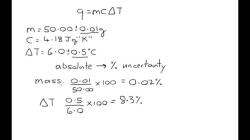How do you calculate the density of a substance?
Calculating Density: A Fundamental Concept in Science
Calculating the density of a substance is a fundamental concept in physics and chemistry that provides valuable information about the mass and volume relationship of a material. Density is defined as the amount of mass per unit volume and is often denoted by the symbol "ρ" (rho). It's a crucial parameter for characterizing materials and understanding their properties. Here's how to calculate density and why it's important:
Method to Calculate Density:The formula to calculate the density of a substance is:
Where:
- Density (ρ): The density of the substance.
- Mass (m): The mass of the substance.
- Volume (V): The volume of the substance.
Importance of Density:
Identification of Substances: Density is a characteristic property of a substance that can help identify and differentiate materials. Each material has a unique density value, allowing scientists and researchers to determine the composition of unknown substances.
Quality Control: In various industries, such as food, pharmaceuticals, and manufacturing, density measurements are used for quality control. Deviations in density can indicate impurities, variations in composition, or production errors.
Buoyancy and Floatation: Density plays a crucial role in determining whether an object will float or sink in a liquid. Objects with lower density than the liquid will float, while those with higher density will sink.
Material Selection: Engineers use density to choose materials for specific applications. For example, aircraft designers select materials with low density to reduce weight and enhance fuel efficiency.
State Changes: Changes in a substance's density can indicate state changes (e.g., from solid to liquid) and phase transitions (e.g., melting, freezing, boiling).
Environmental Monitoring: Density measurements are used to assess pollution levels in bodies of water, as pollutants can affect the density of water.
Geological Studies: Density variations in rocks and minerals provide insights into the Earth's composition and structure. Geologists use density measurements to study the Earth's interior.
Agriculture and Food Production: Density measurements are used to assess the ripeness and quality of fruits, vegetables, and grains.
Medicine: In medical imaging, density is used in techniques like X-ray and computed tomography (CT) scans to differentiate tissues based on their density variations.
Understanding Behavior of Fluids: Density influences fluid behavior in fluid dynamics. It determines the buoyant force, flow patterns, and more.
Calculating density helps scientists, engineers, and researchers understand the physical and chemical properties of materials, make informed decisions in various fields, and improve our understanding of natural phenomena.












